It takes a bit of effort to slip in under the gullwing doors and then wedge oneself into the low-slung seat of the Volkswagen XL1. And it’s even more difficult for my co-pilot as the passenger seat is set slightly rearward, almost tandem-style.
The simple reality is that the windswept two-seater isn’t built for comfort. The Volkswagen XL1 was designed for maximum mileage. And we’re not talking something like the mere 50 to 60 miles per gallon of today’s best hybrids, nor the 100 mpg “equivalent” ratings of some of the latest battery-electric vehicles. No, this diesel plug-in hybrid recently received a mind-boggling rating from European authorities of 261 miles per gallon, far and away an all-time record.
Describing the XL1 as “my baby,” program manager Steven Volckaert notes the project has been underway for more than a decade, with the original goal of squeezing out 100 kilometers from a single liter of fuel. For the metrically challenged, that works out to about 235 mpg.
VW revealed its first attempt in 2009, a tandem-seating concept dubbed the L1. With a somewhat more traditional interior layout – and even better mileage, the XL1 made its world debut at the Geneva Motor Show last February.
But what came as a shock was news that VW would actually put the extreme machine into production, albeit in limited numbers, a year or so from now. Specific details have yet to be worked out, including the price. It’s likely to rival that of some of the German maker’s more luxurious models – but even then, the cost almost certainly won’t come close to covering the actual cost of building the XL1, even if the mileage champ were to start rolling out of the factory in the same volume as more mainstream Volkswagen models like the Golf.
(GM planning to export Spark EV battery-car. Click Herefor the story.)
No surprise considering what it takes to achieve 261 miles per gallon. There were three key elements to the project:
- A super light chassis and body;
- Aerodynamics on the order of the most advanced aircraft; and
- An ultra-efficient powertrain.
The VW XL1 is primarily made out of CFRP, or carbon fiber-reinforced plastic, the same exotic material used in Formula One race cars and the most extreme sports cars like the Volkswagen Group’s Lamborghini Venino. There are other light materials such as magnesium wheels and ceramic brakes, and clever engineering reduced the parts count so only half the normal front cross-member is needed.
The results are impressive, the monocoque, or passenger cell, weighing in at just 197 pounds, the entire vehicle at a mere 1753 pounds.
A variety of wind-cheating tricks also play a role, including full underbody panels and, instead of conventional sideview mirrors the XL1 uses a pair of tiny cameras that display images on LCD screens built into each door.
But the heart of this high-mileage beast is a miniscule 2-cylnder, 0.8-liter 48-horsepower diesel engine paired with a 27-hp electric motor drawing power from a 5.5-kilowatthour lithium-ion battery. The plug-in system will deliver a nominal 32 miles in electric-only mode, though for longer drives, or under more aggressive driving conditions, the diesel will fire up.
(Ford fix should boost hybrid mileage. Click Herefor the story.)
For now, as I hit start, the diesel is idle. The only way to tell the XL1 is ready to roll is by reading the gauge cluster visible between the steering wheel. Putting the dual-clutch manual into gear the little car lurches forward, the only sound gravel crunching beneath its narrow, low-friction tires.
As we weave through traffic in Wolfsburg, VW’s German home, the XL1 draws plenty of stares from pedestrians and other drivers. The car is so small it’s easy to maneuver city streets and though the XL1 has no power steering – too heavy – it’s so light as to be surprisingly nimble.
On local roads, there’s little trouble keeping up with traffic, though the real test comes as we turn onto the A1 Autobahn heading towards Berlin. The good news is that with the vehicle so light, its compact powertrain delivers quicker acceleration than one might expect. It’s no rocket but it’s quicker than some classic econoboxes that might otherwise leave you fearing for your life on the unlimited German freeways.
(First drive: Volkswagen GTD diesel. Click Here for the review.)
Of course, the diesel has finally fired up and, well, no matter how much VW ultimately charges when the XL1 goes on sale you won’t confuse it with a similarly priced luxury car. To save weight, there is almost no sound insulation so the cockpit echoes with the oil-burner’s clacking. Happily, as we exit the Autobahn it quickly shuts down and our ears get a respite as we return to battery power.
We can only hope that VW planners opt to sacrifice a few pounds and a couple mpg when the 2-seater goes into production. Even if it “only” delivered 255 mpg in final trim would potential buyers be disappointed? Unlikely.
In fact, a final check of the gauges as we pull back into VW headquarters show that we’ve been averaging a more thirsty 1.8 liters per 100 km, a “mere” 138 mpg, due to spending so much of our time racing along the Autobahn under diesel power near to the XL1’s top speed of 99 mph. That said, we’d still be able to make the run from Berlin to Frankfurt – or Los Angeles to San Francisco, for that matter – on well less than three gallons of fuel.
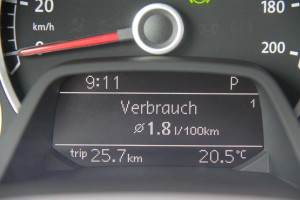
We finish our trip using 1.8 liters per 100 km -- a mere 138 mpg -- because of our time on the Autobahn.
VW expects to produce just a couple hundred copies of the XL1, enough to log some real world data about the various technologies the little car uses.
In the years ahead, however, we can expect to see the design influence more mainstream products as the industry struggles to meet increasing mileage and emissions standards around the world. While 261 mpg requires some real sacrifice from driver and manufacturer alike, the Volkswagen XL1 should help engineers and designers figure out ways to deliver significantly better numbers than the typical automobile delivers today.

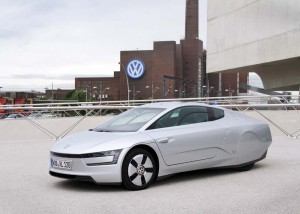
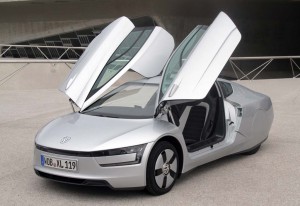
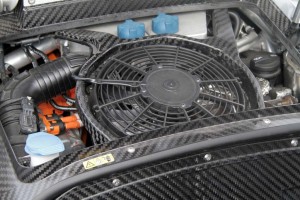
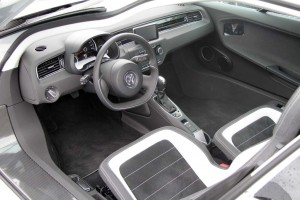
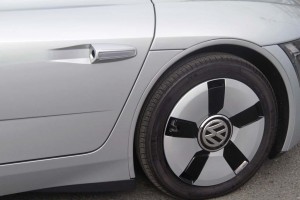
VW gets an “A” for effort. This is a halo car to get publicity and highlight VW’s green initiatives. I expect the model they sell to be equally impractical and most will end up in museums. I suspect it won’t be coming to the U.S. as it probably isn’t designed to meet U.S. crash test and emission requirments which add a lot of weight and costs. It’s a nice engineering exercise but more than likely the best tech is from the development of the 2-cyl. Diesel engine which would normally be quite the shaker.